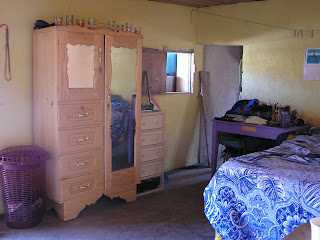I’ve often found that the type of restroom amenities (or lack thereof) becomes a popular conversation topic when traveling. I have friends who have been to Japan who describe not knowing what to do with all the buttons and options for toilet services. I have stayed in places in Europe where the bathroom was so small I could easily sit on the toilet with my feet in the shower and my hands in the sink. I have accompanied friends on their first pit stop in the wilderness and coached them through the use of a hand trowel and techniques for using handy rocks, trees, and logs to find a comfortable position to take care of matters (hopefully with a nice view, and a lack of mosquitoes). At restaurants friends have urged me many times to go use the bathroom, just to check out the décor or ambiance.
So, it’s no surprise that we in Peace Corps end up talking about our bathrooms too. We also commiserate over our actual digestive issues in pretty fine detail, but I’ll spare you publishing that.
The first lesson learned in Guatemala, is to always enter a restroom packing your own supplies.
I've definitely been in this situation in Guatemala, and like to think I've done Macgyver proud, but still... I do my best to avoid needing to get creative.
One of the essential tips we received the first night in country was to remember to put our T.P. in the trash can. This is familiar to most who have traveled in Central or South America, so wasn't much of a surprise.
 |
| Sumpango host family bathroom |
I was a little less prepared for learning how to manually flush the toilet when the water is off -- it's a learned skill of throwing water into the toilet from a bucket nearby just so... to make the contents of the bowl go
down, and not come
out.
Just as throwing T.P. into the trashcan was becoming second nature, I moved to my site, where we use latrines exclusively. Now every time I go into a bigger town, I have to remember to switch back to the wastebasket, then back to the pit again when I get home.
This is the main latrine that the family compound shares. Toward the end of November we had a wind storm come through that blew over two of the walls and blew off the roof of this latrine. The pieces were all more or less propped back into place, but there are gaps in the corners, so people are much more quick to say, "
Occupado!" to prevent others from getting too close while they're inside.
The toilet seat in this latrine was painted with limestone, I think to help keep it disinfected? It tends to have the effect of highlighting whenever someone misses the hole and hits the seat.... happily I now have my own latrine that I can clean when I please.
Some people use their latrines to make their political allegiances known.
My latrine (the one up at my cottage, which I share with the grandfather) is made of adobe. It's got a roof that slopes down from just about exactly my height to much shorter, so I'm a little scrunched, but hey, it's not like I go there to hang out. The boards my left hand is resting on are the makeshift door that I can drag across the entrance should I so choose, but I mostly don't bother unless I know someone's nearby. I prefer the fresh air and the view of flowers growing outside.
The grandfather uses old newsprint for his toilet paper (above left). I bring in my own plush Scott roll. This is one of the things I've decided it's worth splurging for on my Peace Corps budget. I really don't mind using a latrine, but I do mind newsprint. There's also a wooden lid for our outhouse (upper right).
When moving into my new place I had to go through a PC housing checklist for safety and security. One of the requirements for those of us with latrines is to have a cement floor. I've seen (and used) latrines with wooden floors (or just a few wooden boards to balance on) and apparently there have been cases of boards rotting, leaving unsuspecting users to fall down into the latrine. This is definitely one regulation I was happy to comply with!
Besides all the infrastructure issues around restrooms, I've noticed some cultural differences as well. When I go to the public restroom in the mall in Xela or Chimaltenango (these are pretty similar to U.S. malls), the women spread out and stand in lines behind each stall. In the U.S., the line of women forms at the entrance to the restroom and the woman in the front takes whichever stall is vacated first. In Guatemala, it's more like choosing a checkout line in the grocery store. If you choose the one that moves more slowly, tough luck.
There may be a stereotype that U.S. women always go to the bathroom in groups, but I can assure you that when we do, we use separate stalls. In Guatemala I've seen two or three girls entering a stall together, each taking turns at the toilet. I don't just mean 5 year olds here... probably up to 13 or 14 year olds. I'm not saying this is the norm, or very common. But it's definitely not
uncommon. Odd.
Lastly, for all Guatemalans are said to be indirect communicators, they're surprisingly direct on some topics. This includes asking if you have diarrhea and if there was enough toilet paper for you to get by (not to mention how much things cost, how much money you make, if you're homesick/sad, why you are single, and so much more... but those are topics for another day).























